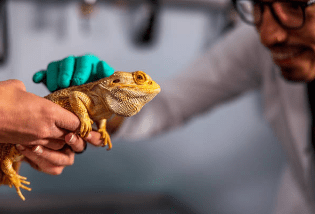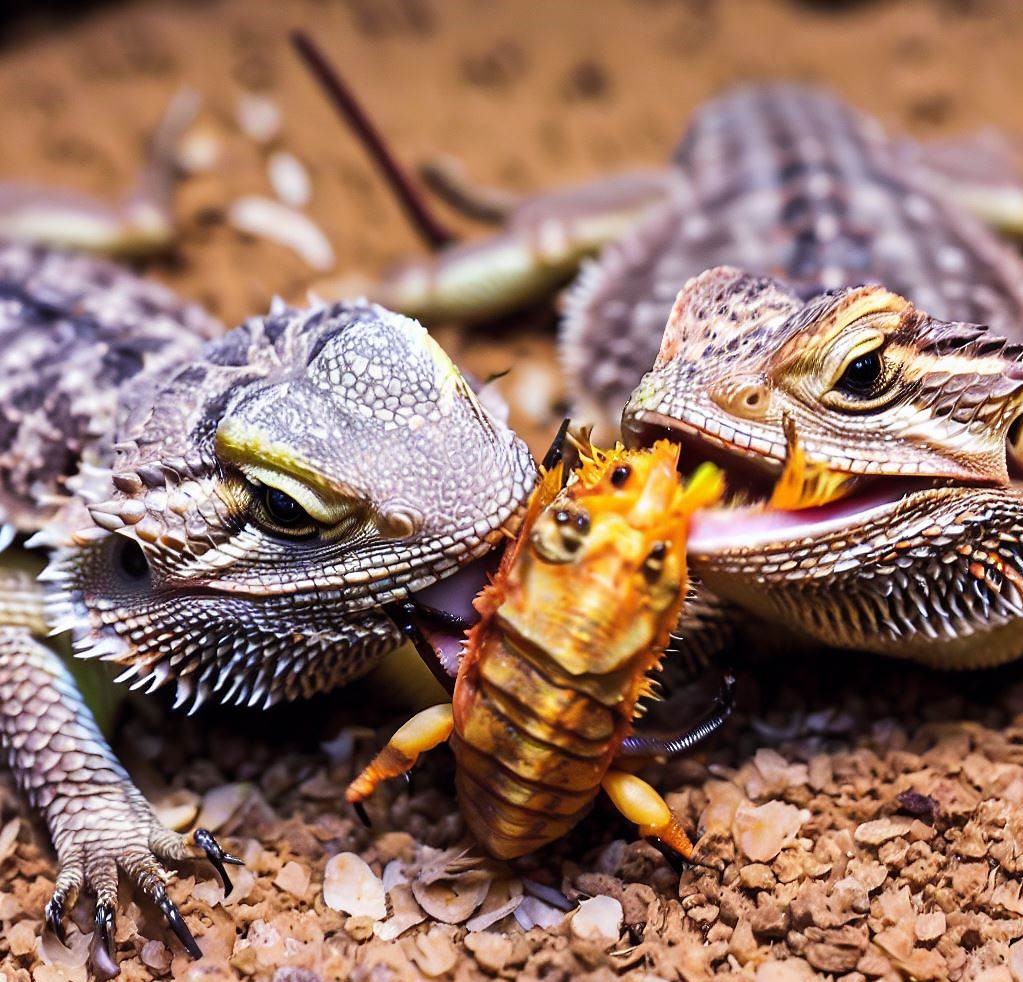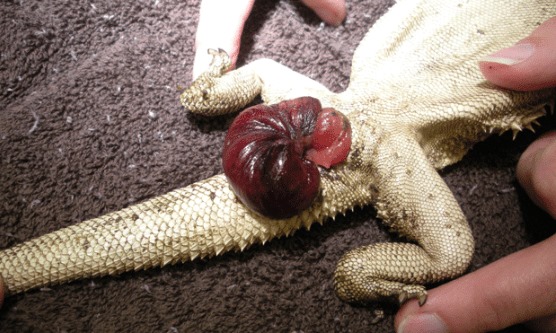Are you startled by your bearded dragon’s odd appearance down there?
You’re in the right place.
As a seasoned reptile expert, I understand that witnessing signs of a bearded dragon prolapse can send chills down any pet owner’s spine.
This guide deepens into this alarming issue, shedding light on its various facets. Hang tight, and let’s unravel the mystery together.
Table of Contents
What is Prolapse in Bearded Dragons?
Before you panic, it’s crucial to grasp what’s happening truly. Prolapse is an unnerving sight, but knowing its science provides clarity. Let’s dissect the subject, shall we?
The Anatomy Involved
A bearded dragon’s anatomy is fascinating and intricate. When we discuss prolapse, two primary types might occur. But what’s the distinction?
Difference Between Intestinal and Hemipenal Prolapse
Distinguishing between these two can take time and effort. The former involves the gut, while the latter concerns the reproductive organs. Recognizing the difference is step one in effective care.
How Prolapse Differs in Young and Adult Bearded Dragons
Age plays a role here. A young dragon’s prolapse may spring from different causes than its adult counterparts. Here’s how they differ and why it matters.
Why Prolapse Occurs in Bearded Dragons: Beyond the Common Causes
It’s only natural to seek reasons when your cherished pet displays unsettling symptoms. Unearthing the causes behind a bearded dragon prolapse can be a journey, sometimes treading beyond the usual suspects.
Lack of Calcium: The Underlying Biochemistry
How does calcium relate to a prolapse? Calcium plays an indispensable role in your bearded dragon’s muscle function. Without it, the strength of vital muscles diminishes, possibly leading to prolapse in bearded dragons.
Signs of Calcium Deficiency Beyond Prolapse
Twitching limbs, lethargy, or a bent tail – the absence of calcium can manifest in various ways. While a bearded dragon prolapse death remains a frightful consequence, picking up on these lesser-known signs is essential.
The Role of Internal Parasites
Parasites, the silent invaders. Their presence in your dragon’s system can exacerbate gastrointestinal issues, increasing the risk of prolapse. Their menacing role should be more discussed.
Types of Parasites
From pinworms to coccidia, the variety of internal parasites can be vast. Understanding each type can help early detection and treatment, reducing the peril of a prolapse bearded dragon encounter.
Diagnostic Tests for Parasites
To defeat an enemy, you first need to identify it. Various tests, like fecal exams, can spot these unwanted guests. Swift detection can mean the difference between an ailment and wellness.
Diarrhea: How it Causes Prolapse
Yes, even something as common as diarrhea can escalate to a prolapse. Rapid bowel movements, especially when chronic, exert undue pressure, making prolapse a more probable event.
Distinguishing Between Normal and Concerning Stool
Every pet owner should be a mini-expert in their pet’s droppings. It’s not the most glamorous job, but discerning between a healthy and a worrisome stool can be a lifesaver.
Impaction: The Silent Culprit
The bearded dragon’s diet is versatile, but sometimes, what they ingest doesn’t leave their system, leading to impaction. This blockage can increase the internal pressure, acting as a precursor to a prolapse in bearded dragons.
Recognizing Early Signs of Impaction
A lethargic dragon, coupled with infrequent droppings, might be signaling impaction. Stay vigilant to these signs. Early detection can prevent prolapse and stave off potential bearded dragon prolapse death.
Dystocia and Laying Eggs
Females have their unique set of challenges. Dystocia, or the inability to lay eggs, can exert tremendous pressure on their bodies. If not addressed, this can inevitably lead to prolapse.
How to Prepare for Your Bearded Dragon’s Egg-Laying
Preparation is half the battle won. Providing an appropriate laying box and monitoring calcium intake can ensure a smoother egg-laying process, safeguarding against prolapse.
Less Common Causes
Only some reasons fit within the conventional bracket. Sometimes, it’s the environment or the diet that plays the unexpected villain.
Influence of Diet
Feeders laden with chemicals or a diet devoid of essential nutrients can indirectly lead to a prolapse. Balanced meals are pivotal for overall health.
Influence of Heat and Light
Improper heat gradients or inconsistent lighting can stress your dragon. This stress, over time, can have physical manifestations, including the dreaded prolapse bearded dragon scenario.
Bearded Dragon Prolapse Death: The Fatal Risks
Every bearded dragon owner’s worst nightmare is losing their scaly companion to a condition that could have been prevented. While a bearded dragon prolapse is distressing, the potential consequences truly alarm. So, what’s at stake?
What Happens If Left Untreated
Neglect is costly. Ignoring the signs of a prolapse in bearded dragons might lead down a dark path. The longer the affected organ remains outside, the higher the chances of complications.
Statistics and Studies
Research paints a grim picture. Studies suggest a significant percentage of untreated prolapse bearded dragon cases end fatally. The numbers reiterate the importance of timely intervention.
Immediate Steps to Take
When the clock’s ticking, every second counts. Witnessing a prolapse necessitates swift, decisive action to prevent a potential bearded dragon prolapse death.
Emergency Vet Care
The first port of call? A reptile-savvy veterinarian. Their expertise can mean the difference between recovery and regret. The sooner you reach out, the better the prognosis.
Recognizing the Symptoms Early
While prevention is paramount, early detection runs a close second. Understanding the nuances of a bearded dragon prolapse can empower you to act timely, even if prevention falls short.
Physical Signs to Look For
A vigilant eye can spot the onset of prolapse. From a visible bulge near their vent to unusual dragging movements, physical manifestations are blatant calls for attention.
Color Changes and Texture
The prolapsed organ might shift in color, ranging from pink to dark red. Its texture might also alter, becoming dry or swollen. Spotting these changes can be your cue to intervene.
Behavioral Signs
It’s not just the physical; it’s the psychological too. A dragon undergoing distress might exhibit altered behaviors – reduced appetite, agitation, or a reluctance to move.
Lethargy and Activity Levels
A usually vivacious dragon turning sluggish? That’s a red flag. A stark shift in activity levels can hint at a lurking prolapse in bearded dragons or associated discomforts.
Step-by-Step Guide to Immediate Care
Now, let’s roll up our sleeves. Encountering a prolapse bearded dragon can be overwhelming, but you can navigate this challenging terrain with a methodical approach.
Preparing a Sugar Water Bath
Before rushing to a vet, a sugar water bath can be a preliminary remedy. It acts as an osmotic agent, drawing out the swelling and helping to reduce the prolapse temporarily.
The Science Behind It
Sugar has an innate ability to pull moisture. When a prolapsed organ is soaked in sugar water, it temporarily shrinks due to dehydration, often easing the prolapse back into place.
Creating a Sugar Paste
In the absence of a bath, a sugar paste works wonders. Applying it to the prolapsed organ can offer interim relief until professional care is sought.
When and How to Move Your Bearded Dragon
Handling a distressed dragon requires finesse. Ensure minimal stress by delicately transferring it to a clean, soft surface, away from gritty substrates.
Relocating from the Enclosure
Safety first! Move your dragon to a separate, sterile container, ensuring it’s free from any substrate that could further irritate the prolapsed area.
When to Visit the Vet
While home remedies offer temporary relief, a veterinarian’s intervention is non-negotiable. Whether it’s an apparent bearded dragon prolapse or a suspected one, schedule a visit without delay.
Identifying a Reptile-Specialist Vet
Not all vets are equal. For specific conditions like a prolapse in bearded dragons, consulting a reptile specialist can offer tailored, more effective solutions, thus potentially averting a bearded dragon prolapse death.

Ultimate Guide to Preventing Bearded Dragon Prolapse
Prevention, they say, is better than cure, and when it comes to a bearded dragon prolapse, truer words were never spoken. Let’s uncover the measures to shield your pet from this predicament.
Importance of Calcium Supplements
Muscle strength is paramount in avoiding prolapse, and calcium is its chief ally.
Types and Brands to Consider
From liquid drops to powders, options abound. Trusted brands like ReptiCal or DragonCal ensure a calcium-rich diet.
Hydration Best Practices
A hydrated dragon is a healthy dragon. Consistent hydration reduces the risk of prolapse in bearded dragons.
How to Properly Hydrate Your Bearded Dragon
Whether regular baths or misting, ensuring your dragon receives ample water is crucial.
Precautions Against Impaction
Impaction, a silent precursor to prolapse, can be deterred with thoughtful measures.
Substrate Choices and Risks
Steer clear from sand or gravel. Opt for reptile mats or newspapers for safer, impaction-free habitats.
Treatment and Recovery: A Comprehensive Roadmap
Recovery is the next pivotal phase once you’ve navigated the storm of a bearded dragon prolapse.
Medical Treatments
Beyond initial care, some cases require medical interventions.
Surgeries and Procedures
For severe prolapses, surgical corrections or stitches might be the path forward, offering your dragon a chance at complete recovery.
Post-Care and Rehabilitation
Aftercare is just as critical as the treatment.
Feeding and Hydration During Recovery

Opt for easily digestible foods and keep hydration levels optimal. These simple steps can expedite healing after a prolapse bearded dragon ordeal.
Conclusion
Navigating the complexities of a bearded dragon prolapse can be daunting. But these challenges can be surmounted with knowledge, timely action, and a sprinkle of love.
Whether prevention or post-care, every step you take ensures your dragon’s prolonged, healthy life, keeping the fears of a bearded dragon prolapse death at bay.
FAQs
What are the causes of prolapse in bearded dragons?
Various factors, including calcium deficiency, internal parasites, impaction, and egg-laying difficulties, can lead to prolapse.
How can prolapse in bearded dragons be prevented?
Regular hydration, appropriate substrate choices, and a balanced diet are key preventive measures.
What are the symptoms of prolapse in bearded dragons?
Visible bulges near the vent, altered behavior, and physical distress are typical signs.
How is prolapse in bearded dragons diagnosed?
A physical examination and a vet’s expertise can confirm a prolapse.
How is prolapse in bearded dragons treated?
Treatments range from sugar water baths and pastes to surgical interventions.
What are the long-term implications of prolapse in bearded dragons?
If untreated, prolapse can lead to infections, tissue death, and bearded dragon prolapse death in severe cases.
What is the prognosis for bearded dragons with prolapse?
With timely treatment and care, many bearded dragons recover fully. However, neglect can have fatal outcomes.
What can be done to prevent bearded dragons from dying from prolapse?
Early detection, immediate professional care, and post-treatment rehabilitation are crucial.
Alina Hartley is a small-town girl with a ginormous love of bearded dragons. It all started with Winchester, a baby bearded who was abandoned at the shelter by his former owners because of a birth defect that caused one front leg to be shorter than the other. Alina originally went to the shelter looking for a guinea pig, but one look at Winchester and it was love at first sight. From that day on, Alina has dedicated her life to learning everything she can about bearded dragons. She loves helping new beardie parents start their incredible journey with these magnificent reptiles.
Follow her on:
LINKEDIN
TWITTER.
Read her latest articles HERE
Learn more about her HERE.

